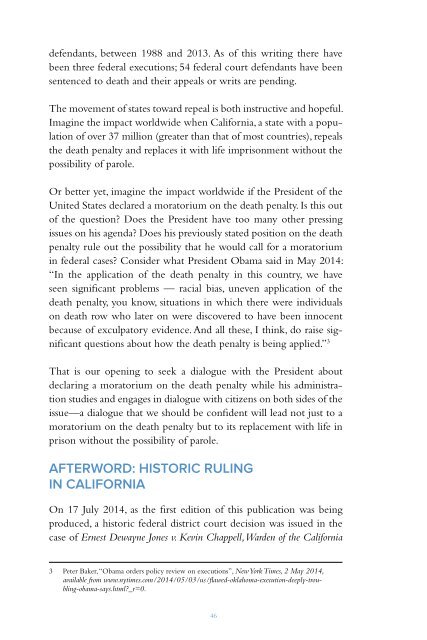PENALTY
DBk0302s7Xm
DBk0302s7Xm
Create successful ePaper yourself
Turn your PDF publications into a flip-book with our unique Google optimized e-Paper software.
defendants, between 1988 and 2013. As of this writing there have<br />
been three federal executions; 54 federal court defendants have been<br />
sentenced to death and their appeals or writs are pending.<br />
The movement of states toward repeal is both instructive and hopeful.<br />
Imagine the impact worldwide when California, a state with a population<br />
of over 37 million (greater than that of most countries), repeals<br />
the death penalty and replaces it with life imprisonment without the<br />
possibility of parole.<br />
Or better yet, imagine the impact worldwide if the President of the<br />
United States declared a moratorium on the death penalty. Is this out<br />
of the question? Does the President have too many other pressing<br />
issues on his agenda? Does his previously stated position on the death<br />
penalty rule out the possibility that he would call for a moratorium<br />
in federal cases? Consider what President Obama said in May 2014:<br />
“In the application of the death penalty in this country, we have<br />
seen significant problems — racial bias, uneven application of the<br />
death penalty, you know, situations in which there were individuals<br />
on death row who later on were discovered to have been innocent<br />
because of exculpatory evidence. And all these, I think, do raise significant<br />
questions about how the death penalty is being applied.” 3<br />
That is our opening to seek a dialogue with the President about<br />
declaring a moratorium on the death penalty while his administration<br />
studies and engages in dialogue with citizens on both sides of the<br />
issue—a dialogue that we should be confident will lead not just to a<br />
moratorium on the death penalty but to its replacement with life in<br />
prison without the possibility of parole.<br />
AFTERWORD: HISTORIC RULING<br />
IN CALIFORNIA<br />
State Prison at San Quentin. Federal Judge Cormac Carney concluded<br />
that California’s death penalty system is dysfunctional and results in<br />
an “inordinate and unpredictable period of delay preceding their<br />
actual execution.” He went on to say that “as for the random few for<br />
whom execution does become a reality, they will have languished for<br />
so long on Death Row that their execution will serve no retributive<br />
or deterrent purpose and will be arbitrary. . . . Allowing this system<br />
to continue to threaten Mr. Jones with the slight possibility of death,<br />
almost a generation after he was first sentenced, violates the Eighth<br />
Amendment’s prohibition against cruel and unusual punishment.”<br />
Mr. Jones has been on California’s death row since April 1995.<br />
The Jones decision can be appealed to the Federal Court of Appeals<br />
by the California Attorney General. If the appeal is heard and the<br />
decision of the district court is affirmed, the decision would then<br />
apply to the entire state—California’s death penalty law would no<br />
longer exist. The California Attorney General could either accept the<br />
appeals court’s decision or appeal it to the United States Supreme<br />
Court. The court of appeal obviously could also reverse the district<br />
court’s decision. Mr. Jones would then be in the position of appealing<br />
that decision to the United States Supreme Court.<br />
This case is historic because it appears to be the first time in the<br />
nation that a federal court judge has concluded that a specific state’s<br />
death penalty law is unconstitutional because of the state’s dysfunctional<br />
death penalty system. While this decision applies to this single<br />
case alone, judges and prosecutors in California can now expect<br />
the same arguments to be made in any pending death penalty case.<br />
Though judges are not required to follow a ruling by a single court,<br />
this especially well-written, exhaustive and well-documented decision<br />
is likely to persuade many judges to follow its lead and declare<br />
California’s state death penalty law unconstitutional.<br />
On 17 July 2014, as the first edition of this publication was being<br />
produced, a historic federal district court decision was issued in the<br />
case of Ernest Dewayne Jones v. Kevin Chappell, Warden of the California<br />
3 Peter Baker, “Obama orders policy review on executions”, New York Times, 2 May 2014,<br />
available from www.nytimes.com/2014/05/03/us/flawed-oklahoma-execution-deeply-troubling-obama-says.html?_r=0.<br />
46 47


